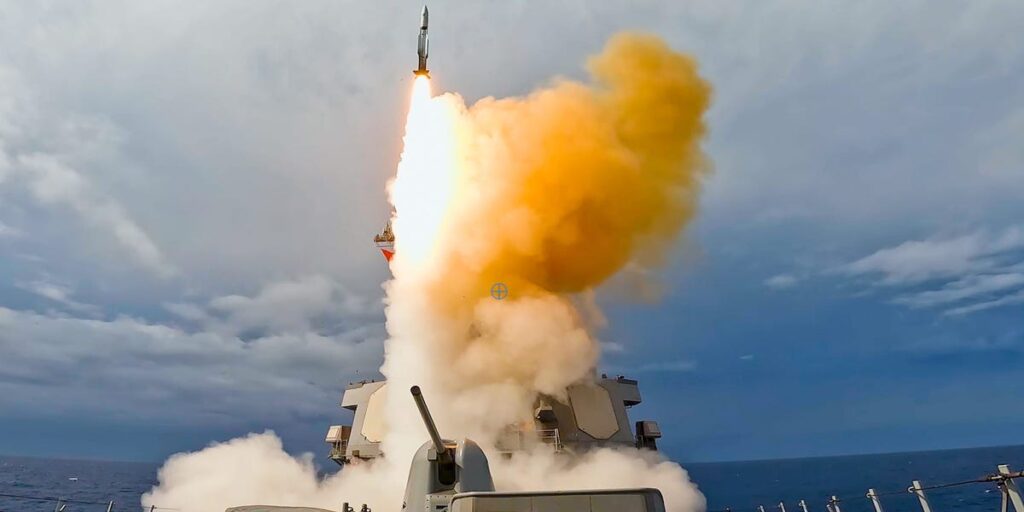NATO warships are sailing into a dangerous new era of naval warfare in which the threats are growing fast, two senior alliance commanders recently told Business Insider.
From the Black Sea to the Red Sea, the conflicts in Ukraine and the Middle East have exposed key vulnerabilities and shown NATO what its naval forces need to operate in risky environments. Dangers to warships these days include threats like hostile drones, missiles, and other naval vessels, capabilities built on rapidly advancing combat technology.
So what does NATO need? Layered defenses, cheaper ways to destroy enemy threats, and deeper ammunition stockpiles.
Vice Adm. James Morley, the deputy commander of NATO’s Joint Force Command Norfolk, told BI that Ukraine and the Red Sea “have revealed the need to be ready to deal with a higher level of intensity than we had previously scaled for, both in terms of stock and in terms of time on the front line.”
In the Black Sea, Ukrainian forces have repeatedly used domestically produced naval drones to damage and destroy Russian warships, showing the risks that relatively cheap, asymmetric combat solutions pose to conventional naval forces.
Far away, at the southern end of the Red Sea, the Iran-backed Houthis in Yemen have launched missiles and drones at merchant vessels and NATO warships defending international shipping lanes.
In its efforts to fend off the Houthi attacks, the US Navy has faced its most intense combat since World War II, US officials have previously said.
Morley said NATO warships are at a higher risk because of the number of global actors who are prepared to use military force.
Weapons proliferation has given actors who might previously have been unable to threaten advanced navies a new ability to do so. In the case of the Houthis, for instance, the group’s missile attacks have raised the level of danger in the Red Sea and Gulf of Aden to a level not seen in years.
The situation is different in Europe, where NATO warships have not been shot at but tensions are running high. There have been several incidents with Moscow that raise the level of risk.
‘The mindset needs to be layered defense’
Surface warships face an expanding range of threats, from anti-ship cruise and ballistic missiles and torpedoes to enemy aircraft and drones. Some weapons now in play only recently saw combat for the first time.
The high operational tempo in the Red Sea has informed Western military planners about what limitations they face regarding magazine capacity, weapons inventory, and reloading capabilities.
Morley said that as the weaponry that can threaten warships increases, so must the defensive capabilities aboard the vessels in danger. It’s important to invest in missile stockpiles and ensure that NATO defense industrial bases can produce enough and ships can carry enough should they sail into a fight.
The days “of driving around with a silo of ammunition that never gets used is sadly now in the past,” he said, explaining that “ships routinely come back from the Red Sea, for example, having expended ammunition, and they need to be resupplied and then get back out on patrol.” US Navy warships, for instance, have expended significant quantities of SM-series interceptor missiles for air defense.
Air defense isn’t just about numbers. It’s also about dollars.
The rise of inexpensive strike drones — some just tens of thousands of dollars apiece — as a tool of naval warfare has NATO forces trying to figure out how they can cheaply defeat these threats without wasting a surface-to-air missile costing millions. The aim is to bring the cost difference between the threat and the interceptor much closer to parity.
“I think the mindset needs to be layered defense,” Morley said. Warships need the expensive, higher-end missiles to deal with sophisticated threats. But breaking the cost-curve challenge means having a range of capabilities so complex interceptors aren’t expended on the simple threats.
American Arleigh Burke-class destroyers, for instance, are kitted with options like the M2 Browning .50 caliber machine guns, Mark 38 turret systems, five-inch artillery cannons, and a variety of surface-to-air missiles. These weapons allow the warships to confront a range of threats, though some options, like the deck guns, come with drawbacks, such as permitting threats to get much closer to warships than desired.
Big platforms aren’t obsolete
Adm. Pierre Vandier, NATO’s Supreme Allied Commander Transformation, who oversees alliance modernization efforts, said emerging technologies, like drones, have created new problems for larger platforms like warships, as has been the case in the Black Sea. Anything that exists on the water could effectively be hit.
Vandier identified uncrewed systems as one of the biggest changes in naval warfare over the past decade and said one risk is that a warship could be overwhelmed by a swarm of drones.
“You need to find ways on the ships to be protected from that and to engage multiple targets at the same time,” he said. That could be kinetic, involving a physical strike, or some alternative, like electronic warfare.
NATO is working to incorporate lessons learned from Ukraine and the Red Sea into its combat training. At last month’s Formidable Shield 25 exercise, US sailors practiced using the deck guns to shoot down small quadcopter drones that they could face in a swarm attack.
They also practiced defending against uncrewed surface vehicles like the ones Ukraine has used to batter Russia’s Black Sea fleet.
Exercises such as Formidable Shield allow allied navies to practice navigating air defense challenges and learn how to engage cheaper threats with cheaper defenses, thus saving the more expensive methods for the higher-end threats.
Despite the growing number of threats to warships, Vandier said the rise of drones doesn’t necessarily render them obsolete. Aircraft carriers, the flagships of a fleet, can project force globally with embarked aviation. They travel in heavily defended strike groups, making the carriers particularly formidable and hard to reach for enemy attacks.
“To get to a carrier, you have layers,” Vandier said. “It’s a battle between the shield and the sword. My personal feeling is that the story is not finished for the big platforms. Not yet.”
Read the full article here
















